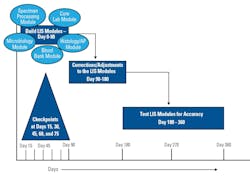Project management in the clinical laboratory: A hybrid approach
Clinical laboratory leaders are often tasked with implementing change. Whether a simple process revision, or a more complicated initiative, these changes can quickly develop into complex projects. The approaches taken to managing these projects can significantly impact their success. Administrative leaders in the clinical laboratory typically oversee four common disciplines: financial management, quality management, personnel management, and operations management. However, where does project management fit in, and how do we begin to plan for it?
In the clinical laboratory, projects, although temporary in nature, are part of the continuous process of quality assurance and initiatives. Laboratorians have not always consistently defined what we know as fundamental routine work as “projects.” However, we have always taken a measured and systematic approach when performing these tasks to ensure expected outcomes. “In general, a project is defined as a one-time activity that has to be completed within a limited time and has a well-defined outcome.”1 Examples of common clinical laboratory projects include new instrument installations, test method validations and verifications, and process quality improvements. Each of these initiatives requires strict planning and project oversight, and for many projects, there will inevitably be some obstacles to overcome. We can mitigate these challenges by applying a standard method of project management that has been proven to work in other industries.
Two common methods exist in project management: waterfall and agile methods. While both have been proven to work successfully in project development, they follow different methods of working through and completing the project. The waterfall and agile project management methods originated in technical industries like engineering and software development. However, with the constant need for change and improvement in healthcare, these methods, or a hybrid of the two, are becoming more popular with industry leaders.2 Below, we will discuss some key differences in the methods, show examples of how each could work in the clinical laboratory, and discuss which type we have found successful in laboratories.
Project management methods: waterfall and agile
So, how are the two project management methods different, and why should you choose one over the other? The key difference between the two styles is how the project tasks are worked through. The waterfall method is a way to tackle the project with a more methodical, defined, and rigid structure, and is sometimes referred to as the classical linear method or predictive approach. This is because it adheres to a strict timeline and completes each project phase before moving to the next. Whereas the agile method allows the project to develop organically with more flexibility and in a team-driven environment.3 The agile method segments and assigns each of the larger portions of the project to different teams to tackle the project in a manageable way together.4
For example, let’s assume a hospital laboratory is implementing a new laboratory information system (LIS), and “go-live” is expected 12 months from today. With the waterfall method, the project may be constructed as follows:
- Build the specimen processing module in months 1 and 2.
- Build the core lab (hematology/coagulation/chemistry/urinalysis) module in months 3, 4, and 5.
- Build the microbiology module in months 6 and 7.
- Build the blood bank module in months 8 and 9.
- Build the histology/anatomic pathology module in month 10.
- After constructing each of the lab section modules, testing of these modules will commence in months 11 and 12.
Whereas the agile approach (also referred to as “adaptive” project management) for implementing this same LIS may look completely different. This approach is commonly used when there is a high level of understanding of the outcome, but the best way to achieve that outcome is not strictly defined.5 Using this method with the LIS example, each of the lab section modules builds could be assigned to teams to tackle their sections simultaneously. With the agile method, the project may be constructed as follows:
- All sections in the laboratory work on building their assigned modules.
- All sections build their reference ranges.
- All sections run test samples to ensure the LIS is working appropriately.
While both waterfall and agile methods have seen success in different industries, after talking with other laboratory leaders, we have found that a hybrid of the two methods works better for laboratory projects than just specifically using waterfall or agile alone. The hybrid project management model combines the most advantageous parts of the waterfall and agile methods to fit the project's needs. “Many hybrid projects use a waterfall framework at a high level and apply agile approaches to specific deliverables as appropriate.”5 Marie Cole, Clinical Laboratory Administrative Director overseeing multiple sites in the San Antonio, Texas area spoke about a recent project that required adding new pathology services at one of her laboratories. After the project started, she stated, “The team started working hard and solving problems; however, things would pop up that we hadn’t thought about. So, we had to be flexible enough to be able to address them (agile approach).” However, Marie also said that “although time is one of her biggest obstacles when managing a project, it is imperative to stay on top of it and stick to your deadlines (waterfall approach).” Marie’s methods of blending these project management styles indicated she was using a hybrid approach to project management, and this was consistent with other laboratory leaders in the area. Without labeling as such, the combination or “hybrid” of the waterfall and agile project management methods appears to be a common practice used in the clinical laboratory today. Below, we will highlight an example employing the hybrid project management method.
Using the hybrid method in the laboratory
Basic project management mainly involves planning, scheduling, executing, and controlling.1 A strategic approach could be to use the hybrid method on our LIS implementation project, while also incorporating these four key elements to ensure the project runs smoothly. We can use the agile method to complete the builds of each laboratory section module and then use the waterfall approach to test the module builds. Let’s take our LIS implementation example from earlier and apply the hybrid approach with the four key elements of project management.
Step one – Planning: Identify key stakeholders, develop a team, and define activities
Not all clinical laboratories have the resources to hire a project management professional or team to develop, implement, and oversee their projects. Marie Cole said she “first approaches any project by identifying the key stakeholders and developing a team.” Developing a team can be difficult for some laboratories with more technical staff than administrative help, so having a well-thought-out plan is critical. In our LIS example, our laboratory director first announces to all stakeholders (all laboratory staff) that the laboratory will transition to a new LIS in 12 months. After the initial announcement, the laboratory director also formed the project team and held face-to-face conversations with each of the laboratory section leaders to recruit their help in building their assigned laboratory section modules (activities). Now that all stakeholders have been identified, the project team has been created, and the project activities are defined, the project can now move forward to outlining time expectations.
Step two – Scheduling: Set time expectations
Using our LIS implementation project example, the laboratory director and the newly developed team of laboratory section leaders decided to perform the laboratory section module builds in 90 days, with checkpoints at days 15, 30, 45, 60, and 75. The team also decided that the next 90 days would be used to make necessary adjustments to their module builds, and the last 180 days would be dedicated to testing the system.
Step three – Execution: Launch of the project
Now that the project schedule is finalized, the project can officially launch. Because we’re applying the hybrid method to this LIS implementation, each of the laboratory section modules is being built at the same time. Then, the project management team will continue testing the functionality and accuracy of each module build (Figure 1). However, remember that a characteristic of the agile approach is that it offers more flexibility than the classic linear waterfall method. So, our project management team included time considerations to accommodate unexpected changes (agile method), while staying within the allotted timeframe before moving on to the testing phase (waterfall method).
Step four – Controlling: Monitor for success
“To keep project progress as per the plan, a project requires a certain level of control.”1 The checkpoints that were defined during the scheduling phase were included to give the project team an opportunity to assess their progress and identify additional needs. These checkpoints also provided a forum for team collaboration and project status and momentum updates. At the end of the project, we must determine its success. Were deadlines met? Did the project accomplish the goal that was set? Are stakeholders satisfied with the result? Each project will have unique circumstances that may require a more structured format, a more fluid approach, or a hybrid of the two. Either way, applying the four key elements of project management with the hybrid method can result in effective and efficient outcomes.
Conclusion
In conclusion, while project management methods are not routinely discussed in clinical laboratories, many laboratories will unintentionally employ one method, or a combination of methods. The waterfall method involves a more rigid, time-driven approach, whereas the agile method is more adaptive and allows for more flexibility. Speaking to various clinical laboratory leaders revealed that a hybrid of the two methods seems to be a common practice. Although the term “project management” may be an unfamiliar concept in the clinical laboratory, the opportunity to apply these techniques — waterfall, agile, or a hybrid of the two, can be a useful tool. Therefore, clinical laboratory leaders could benefit from exploring the use of these methods to organize and streamline future projects.
References
1. Bansal, V. Project Management: Planning and Scheduling Techniques. Routledge; 2023.
2. Bianchi MJ, Conforto EC, Rebentisch E, Amaral DC, Rezende SO, De Padua R. Recommendation of Project Management Practices: A Contribution to Hybrid Models. IEEE Transactions on Engineering Management. 2022;69(6):3538-3571.
3. Portny, J.L., Portny, S.E. Project Management for Dummies. John Wiley & Sons, Inc.; 2022.
4. Institute, P. The Guide to the Project Management Body of Knowledge (PMBOK® Guide): Seventh Edition. Project Management Institute; 2021.
5. Dionisio, C.S., Hybrid Project Management. John Wiley & Sons, Inc.; 2023.
About the Author

Nathalie Austin, MBA, MLS(ASCP)
is currently a Clinical Assistant Professor at Texas State University's Medical Laboratory Science program. Over the past 23 years, Nathalie has focused on quality management and held leadership positions in the clinical laboratory ranging from technical supervisor of a microbiology department to multi-site laboratory director.

Autumn Vela, MHA, MLS(ASCP)CM SHCM
is a Clinical Assistant Professor at Texas State University, where she teaches courses in the Medical Laboratory Science program. She has a strong background in the clinical laboratory, having held various roles, including her last position as a multi-site manager overseeing three clinical hospital laboratories.

